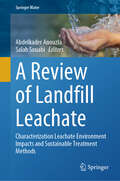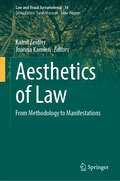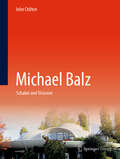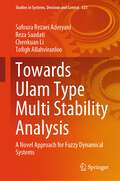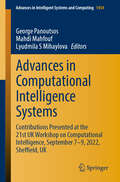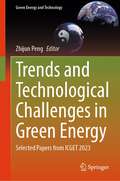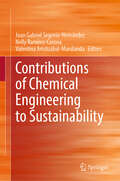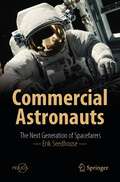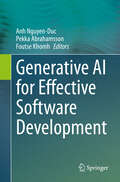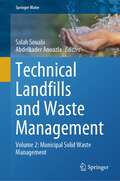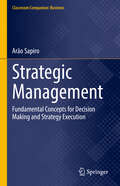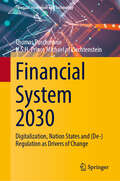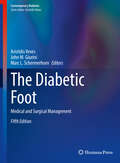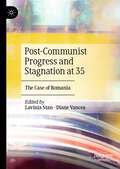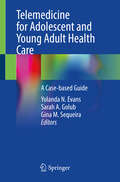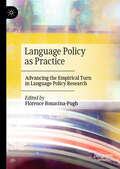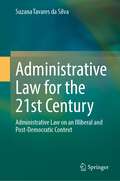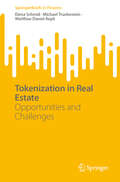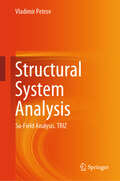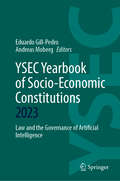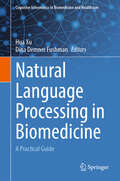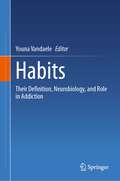- Table View
- List View
A Review of Landfill Leachate: Characterization Leachate Environment Impacts and Sustainable Treatment Methods (Springer Water)
by Salah Souabi Abdelkader AnouzlaSolid waste landfilling and related environmental issues have become global concerns, particularly in developing countries. Accelerating population growth and changing lifestyles have exacerbated health and environmental challenges. This book looks at the global ramifications of leachate characterization and environmental impacts, highlighting the different issues related to landfilling, such as leachate generation and its constituents. When water enters a landfill, it assimilates the dissolved components of the decomposing waste, thus forming a leachate with considerable impacts on the environment. The nature of the landfill and the waste received (household waste alone or mixed with industrial waste) determine whether the leachate produced is hazardous or not. The decomposition of solid waste in landfills goes through several stages, including an initial aerobic phase, an anaerobic acid phase, an initial methanogenic phase and a stable methanogenic phase. Leachates can contain significant concentrations of heavy metals, inorganic salts, ammonia, halogenated hydrocarbons, suspended matter, organic pollutants in significant quantities... Generally, leachate discharges are rich in phenol, highly toxic polluting ammonium. Ecotoxicological assessment of this effluent is essential to determine the impact of its contaminants on the aquatic ecosystem. If pollutants are not disposed of properly, leachate from landfills can potentially enter soils and subsoils, severely contaminating surface and groundwater bodies. Therefore, reducing pollutant levels through leachate treatment has garnered considerable attention in recent decades. This publication is an invaluable resource, providing up-to-date information on the impact and characterization of leachate landfills. It is therefore time to accentuate the training of executives with all the skills to facilitate the waste management through the research efforts of academics, in the field of solid wastelandfill operations.
Aesthetics of Law: From Methodology to Manifestations (Law and Visual Jurisprudence #14)
by Kamil Zeidler Joanna KamieńThe aesthetics of law deals with the relationship between law and beauty by searching for aesthetic values in the law itself (an internal perspective), by finding material related to law in art and culture (an external perspective), and, lastly, by demonstrating the impact of legal norms on what can be broadly understood as beauty (law as a tool of aestheticization). Regarding all these phenomena, the aesthetics of law ultimately allows us to see the law more clearly and more profoundly. What is more, the law does not function, nor has it ever functioned, separately from its means of expression, which are incontrovertibly subject to aesthetic interpretation. If we think about law in this way, perceiving not only the message, but also the manner in which it is conveyed, the whole set of means and tools used, the perfection and beauty of the form, then we will see art in it. After all, the widely known and still applicable ancient maxim ius est ars boni et aequi equates law and art. This alone should be an argument for aesthetic reflection on the law, a field of endeavour that should never have been abandoned. The book’s twenty-three chapters, written by scholars from various countries and three continents, are thematically diverse. In them we present the manifestations of the aesthetics of law from an external perspective. If we accept a definition of the concept of law that is as broad as possible, not only as a synonym of a certain formalized normative system, but also including the process of its creation (legislation), its application and interpretation (jurisprudence), and even teaching on and research into it (doctrine), we can identify a wealth of aesthetic references in the law. A broadly understood aesthetics of law, approached solely from an external perspective, covers such disciplines as law and literature, the aesthetics of legal rhetoric, the trial as performance, the aesthetics ofcourthouse architecture, law in the fine arts, law in film, law and music, pictorial law, symbols of the law and legal symbols, symbols of the state and power, legal archaeology etc. The field of research is, therefore, wide. In addition to topics traditionally and obviously associated with the aesthetics of law, such as law and literature, law in the fine arts, and court rhetoric, there are chapters on e.g. legal ethics and trademarks. All authors share the belief that beauty in law is important, even when it is hidden in a caricature. Further, they argue for restoring the aesthetics of law to its proper place in philosophical and legal discourse, as doing so would yield a host of benefits for the addressees of law.
Michael Balz: Schalen und Visionen
by John ChiltonDieses Buch gibt einen Überblick über das Werk des Architekten Michael Balz, dem Pionier der Betonschalenarchitektur. Es behandelt seine realisierten und nicht realisierten Projekte, von denen viele in Zusammenarbeit mit dem renommierten Schweizer Ingenieur Heinz Isler entworfen wurden.Michael Balz. Schalen und Visionen ist reichlich mit Originalzeichnungen und Fotos illustriert: Schalen und Visionen trägt dem zunehmenden Interesse am Entwurf und der Konstruktion von Stahlbeton-Freiformschalen Rechnung, das mit dem Aufkommen von 3D-Modellierungs- und Formfindungssoftware einhergeht. Das Buch beschreibt architektonische Entwürfe und praktische Konstruktionsfragen, um zeitgenössische Schalendesigner zu motivieren.Balz' Erfahrung im Umgang mit Schwierigkeiten wie der Unvereinbarkeit mit nicht-strukturellen Merkmalen und dem Einbau von Fenstern in Schalen sowie der Bewertung der langfristigen Leistungsfähigkeit von Gebäuden ermöglicht es den Lesern, leichterzu lernen, wie sie mit solchen Problemen bei ihrer eigenen Arbeit umgehen können.Das Buch stellt Michael Balz vor, seine frühe Arbeit mit anderen Architekten, einschließlich seiner Arbeit an pneumatischen Formen mit Frei Otto, und seine Entwicklung zu einem Vertreter der organischen Architektur. Anschließend werden realisierte Projekte besprochen, darunter das Theater unter den Kuppeln (1976), der Ballettsaal (1979) und das Haus Balz (1981). Wettbewerbe, an denen Balz teilgenommen hat, und nicht realisierte Rohbauprojekte finden ebenfalls Beachtung, ebenso wie seine Arbeiten im städtischen Maßstab, wobei die konzeptionellen Entwürfe für Megastädte im Mittelpunkt stehen. Seine visionären Megastrukturen ermutigen Architekten, angesichts der zunehmenden Urbanisierung innovative Lösungen für den Stadtraum zu finden. Michael Balz: Schalen und Visionen wird für Studenten und Fachleute aus den Bereichen Architektur, Bauingenieurwesen, Bauwesen und Stadtplanung vonInteresse sein. Die Überlegungen zu den kulturellen und kontextuellen Aspekten von Balz' Werk werden dem Architekturhistoriker helfen, seine langfristige Bedeutung zu schätzen.
Towards Ulam Type Multi Stability Analysis: A Novel Approach for Fuzzy Dynamical Systems (Studies in Systems, Decision and Control #523)
by Reza Saadati Tofigh Allahviranloo Safoura Rezaei Aderyani Chenkuan LiThe main target of this book is to present a new concept of Ulam-type stability, i.e., multi-stability, through the classical, well-known special functions and to obtain the best approximation error estimates by a different concept of perturbation stability including fuzzy approaches for uncertainty considerations. This stability allows us to obtain diverse approximations depending on various special functions that are initially chosen and to evaluate maximal stability and minimal error which enable us to obtain a unique optimal solution of functional equations, inequalities, and fractional equations. Stability analysis in the sense of the Ulam and its different kinds has received considerable attention from the researchers. However, how to effectively generalize the Ulam stability problems and to evaluate optimized controllability and stability are new issues. The multi-stability not only covers the previous concepts but also considers the optimization of the problem and provides a comprehensive discussion of optimizing the different types of the Ulam stabilities of mathematical models used in the natural sciences and engineering disciplines with fuzzy attitudes. Besides, this book also deals with nonlinear differential equations with various boundary conditions or initial value problems, based on the matrix Mittag-Leffler function, fixed point theory, as well as Babenko's approach to study uniqueness and existence of solutions. In general, the benefits for the readers can be concluded as follows: 1. Evaluates maximal stability with minimal error to get a unique optimal solution. 2. Discusses an optimal method of the alternative to study existence, uniqueness, and different types of Ulam stabilities under special consideration of the fuzzy approaches. 3. Delves into the new study of boundary value problems of fractional integro-differential equations with integral boundary conditions and variable coefficients.
Advances in Computational Intelligence Systems: Contributions Presented at the 21st UK Workshop on Computational Intelligence, September 7-9, 2022, Sheffield, UK (Advances in Intelligent Systems and Computing #1454)
by George Panoutsos Mahdi Mahfouf Lyudmila S MihaylovaThe scope of this book is to present the papers included at the 21st UK Workshop on Computational Intelligence (UKCI 2022), hosted by The University of Sheffield, between 7 and 9 September 2022, Sheffield, UK. This marks the first fully in-person UKCI conference, following the pandemic, a testament to the success and resilience of the UKCI community, as well as to the importance of computational intelligence (CI) research. The papers in this book are divided into five sections: fuzzy logic systems, machine learning, hybrid methods and network systems, deep learning and neural networks, and optimization and search.
Trends and Technological Challenges in Green Energy: Selected Papers from ICGET 2023 (Green Energy and Technology)
by Zhijun PengTrends and Technological Challenges in Green Energy: Selected Papers from ICGET 2023 offers readers selected and expanded papers from the 2023 8th International Conference on Green Energy Technologies held at the University of the Applied Sciences in Hamburg, Germany. It features innovative work by academics, researchers, and industry experts highlighting the latest renewable energy developments. The book covers fundamental and practical applications for green energy resources, including security, energy consumption, localization, energy access, environment-friendly energy systems, sustainable energy development, energy-saving technologies, and conservation. It is a valuable interdisciplinary reference for young researchers, postgraduate students, professionals, and industry practitioners working with green energy technology and applications.
Contributions of Chemical Engineering to Sustainability
by Juan Gabriel Segovia-Hernández Nelly Ramírez-Corona Valentina Aristizábal-MarulandaThis book discusses the recent advancements in chemical engineering and their role in achieving the United Nations' 2030 Agenda and Sustainable Development Goals (SDGs). Addressing these goals involves tackling intricate and interdisciplinary challenges.Chemical engineers have been diligently addressing a diverse array of issues across academia, society, and industry, with the aim of positively impacting these goals.The book offers essential insights and detailed analyses for each SDG. It explores the challenges encountered within various applications and proposes solutions based on foundational engineering principles. The book's content is tailored to professionals, students, and researchers across diverse fields, including engineering, environmental science, and biotechnology.
Commercial Astronauts: The Next Generation of Spacefarers (Springer Praxis Books)
by Erik SeedhouseThe beginning of the 2020’s witnessed dozens of commercial astronauts fly to space on a variety of vehicles. These spacecraft included SpaceX’s Crew Dragon, which supported the Inspiration4 and Axiom Space missions, Virgin Galactic’s SpaceShipTwo, which supported several suborbital science flights, and Blue Origin’s New Shepard spacecraft, which not only flew celebrities but also its fair share of commercial astronauts. The story of this new breed of spacefarer has only just begun. As evidenced by these missions, commercial spaceflight has grown beyond passengers simply traveling to space just for the ride. With orbital flights involving commercial astronauts staying in space for several days and weeks, companies such as Sierra Space, Axiom Space and Blue Origin are preparing for the next steps in commercial space travel which include the construction of orbiting habitats. But how will the opportunities for commercial astronauts develop, how will they be trained, and will this new group of astronauts evolve? This book describes how the commercial spaceflight industry is evolving, how it will continue to evolve as barriers to entry are reduced, competition grows, and costs are lowered, and how, because of these efforts, opportunities for commercial astronauts will increase.
Komorbidität: Symptome, Zustände, Verhalten und Behandlungen
by Einar Thorsteinsson Rhonda BrownDieses Buch stellt eine neue Theorie über die erhebliche Komorbidität vor, die zwischen vielen Krankheiten und Störungen und gleichzeitigen Symptomen wie Schmerzen, Schlafstörungen und Müdigkeit besteht. Zu den besprochenen Krankheiten und Störungen gehören Adipositas, Diabetes mellitus Typ II, medizinische Erkrankungen wie Herz-Kreislauf-Erkrankungen und Schlafstörungen, Essstörungen sowie affektive Störungen (Angst und Depression). Das Buch geht davon aus, dass die Komorbiditäten das Ergebnis eines komplexen bio-psycho-behavioralen Mechanismus sind, der eine Störung des zirkadianen Rhythmus einschließt. Es untersucht methodische (z. B. Mess-) Probleme, die das Verständnis der Komorbidität erschweren können, und erforscht ein breites Spektrum neuer, bestehender und neu entwickelter Therapieansätze, die bei der Behandlung komorbider Störungen von Nutzen sein könnten.
Generative AI for Effective Software Development
by Pekka Abrahamsson Anh Nguyen-Duc Foutse KhomhThis book provides a comprehensive, empirically grounded exploration of how Generative AI is reshaping the landscape of software development. It emphasizes the empirical evaluation of Generative AI tools in real-world scenarios, offering insights into their practical efficacy, limitations, and impact. By presenting case studies, surveys, and interviews from various software development contexts, the book offers a global perspective on the integration of Generative AI, highlighting how these advanced tools are adapted to and influence diverse cultural, organizational, and technological environments. This book is structured to provide a comprehensive understanding of Generative AI and its transformative impact on the field of software engineering. The book is divided into five parts, each focusing on different aspects of Generative AI in software development. As an introduction, Part 1 presents the fundamentals of Generative AI adoption. Part 2 is a collection of empirical studies and delves into the practical aspects of integrating Generative AI tools in software engineering, with a focus on patterns, methodologies, and comparative analyses. Next, Part 3 presents case studies that showcase the application and impact of Generative AI in various software development contexts. Part 4 then examines how Generative AI is reshaping software engineering processes, from collaboration and workflow to management and agile development. Finally, Part 5 looks towards the future, exploring emerging trends, future directions, and the role of education in the context of Generative AI. The book offers diverse perspectives as it compiles research and experiences from various countries and software development environments. It also offers non-technical discussions about Generative AI in management, teamwork, business and education. This way, it is intended for both researchers in software engineering and for professionals in industry who want to learn about the impactof Generative AI on software development.
Technical Landfills and Waste Management: Volume 2: Municipal Solid Waste Management (Springer Water)
by Salah Souabi Abdelkader AnouzlaThis book examines the issue of solid waste generation and management as a worldwide phenomenon, focusing on strategies that facilitate the disposal and utilization of waste while ensuring environmental integrity and meeting the needs of future generations. The process of urbanization, particularly in densely populated cities, has resulted in a notable increase in the production of solid waste. Unfortunately, the current management system employed by the government, as well as the available resources and technical capabilities, is insufficient in effectively addressing this issue. As a result, the accumulation of solid waste in the environment continues to rise, causing adverse impacts on both the natural surroundings and human well-being. The contamination of the air, soil, and water directly stems from this mounting waste. To confront this global challenge, determined efforts are being made to manage and diminish the volume of solid waste, with the ultimate goal of safeguarding the environment and preserving the welfare of future generations. Furthermore, the book delves into various sustainable development approaches, such as Gasification and Ash Melting, Anaerobic Digestion, and Composition. Additionally, it highlights the recent advancements in these techniques by scientists, which contribute to promoting sustainable solid waste management.
Strategic Management: Fundamental Concepts for Decision Making and Strategy Execution (Classroom Companion: Business)
by Arão SapiroThis book provides students with the fundamental concepts and stages of strategic management and planning in organizations with essential tools to make decisions in order to remain competitive in the business world of today. It offers an introduction to the key topics and themes of organizational and competitive strategies and provides a panoramic view of the changing corporate environment. The author draws on insights from various typical functional courses, such as marketing, finance, and accounting, to help students understand how top executives and managers make the strategic decisions that drive successful businesses. Students learn how to conduct a case analysis, measure organizational performance, and conduct external and internal analyses. The book features learning objectives, glossaries, and real cases related to the content of each chapter. The book also features discussions on the execution and evaluation of organizational performance; environment,social, and governance (ESG); and decision and risk analysis. This book is useful for upper undergraduate and graduate level courses in strategic planning and management, business administration, decision making, and business strategy.
Financial System 2030: Digitalization, Nation States and (De-)Regulation as Drivers of Change (Financial Innovation and Technology)
by Thomas Puschmann H.S.H. Prince of LiechtensteinThe financial system is currently confronted with tremendous challenges from the global economy, trade, politics, demographics, and most recently from enormous technological advancements. These developments have the capacity to change the existing financial system fundamentally. This book addresses how technological developments and digitalization will impact the future of financial systems. This book is based on the results of a series of ten roundtables with high-level experts on the future of the financial system. Experts from academia, supranational institutions, central banks, commercial banks, regulators, start-ups, technology companies, venture capital firms, think tanks, foundations, and other visionaries from five continents developed potential scenarios of the financial system 2030 over a time horizon of five years. The book presents the results of these discussions, which are structured along the ‘Vaduz Architecture’. This newly introduced concept distinguishes different dimensions for the future financial system, including information technologies, nation states and (de-) regulation.
Human Flourishing, Spiritual Awakening and Cultural Renewal: Personal and Communal Challenges
by Francisco Díaz Estrada Catalina Elena Dobre Rafael García PavónThis book seeks to generate a theoretical and a reflective framework to re-connect people with culture and spirituality. It seeks to recreate important links between these domains to provide interpretative, foundational, and ethical perspectives. It is distinctive in that it focusses on the challenges that humanity is facing at a cultural, social, moral, and spiritual level. It provides a philosophical understanding of humanity from a humanistic and multidisciplinary perspective (encompassing ethics, language, art/cinema, political, cultural and gender approaches) and offers a variety of ways of how we can rethink our culture and our society for the future.
The Diabetic Foot: Medical and Surgical Management (Contemporary Diabetes)
by Aristidis Veves John M. Giurini Marc L. SchermerhornThe fifth addition of this classic text that focuses on the diabetic foot continues the tradition of the previous four editions. More specifically, it includes contributions from a distinguished panel of clinicians and researchers, who have either participated in previous editions or are new, who provide up-to-date information on the pathophysiology and management of diabetic foot ulceration. As with the previous editions, it is divided into three sections: the first part focuses on clinical features and diagnosis; the second on pathophysiology; and the third on the management of diabetic foot problems. The main emphasis of the clinical part is on the multidisciplinary approach that has been mainly developed by the world-renowned Joslin-Beth Israel Deaconess Foot Center, which pioneered the management of diabetic lower extremity problems. Also like previous editions, the author panel includes diabetologists, podiatrists, vascular surgeons, infectious disease specialists,orthotists, plastic and orthopedic surgeons, the majority of whom work at the Joslin-Beth Israel Deaconess Foot Center. In addition, the fifth edition not only describes the state-of-the-art current methods in clinical practice but also includes a thorough update of all research progress during the last five years. This updated edition of this timely text will be of significant value to all physicians and researchers with interest in a comprehensive understanding of the diabetic foot.
Post-Communist Progress and Stagnation at 35: The Case of Romania
by Lavinia Stan Diane VanceaThis book examines Romania’s efforts to consolidate liberal democracy and market economy, as desired by the generation who effected change in 1989 and required by the European Union. The ousting of Nicolae Ceausescu, leader of an autarchic and nationalistic dictatorship, underscored the limitations of politically engineering change when rule of law is weak, institutions are misused, and intolerance and cheating are prevalent. Despite initial hopes, Romania’s transition combined progress and stagnation, missed opportunities, detours, unintended consequences, and success. The contributions illustrate the tenuous relationship between continuity and change in a country that is yet to catch up with its neighbors.
Telemedicine for Adolescent and Young Adult Health Care: A Case-based Guide
by Yolanda N. Evans Sarah A. Golub Gina M. SequeiraWhile there are general texts on telemedicine and guidelines on the use of telemedicine in pediatrics, there are no texts focused specifically on the provision of health care to adolescents and young adults using telemedicine. Adolescents and young adults have more unique health care needs than both adults and children, including the need to receive developmentally appropriate services and care that may be provided in settings outside of the standard clinical office (such as school-based care). In addition, in most US states, adolescents are capable of providing consent for some but not all medical care, highlighting the critical importance of providing services in a manner that adheres to regulations around consent and confidentiality. Telemedicine for Adolescent and Young Adult Health Care offers readers case-based content written by experts in the fields of adolescent medicine and telemedicine. There are a variety of chapters that include anemphasis on equity, diversity, and inclusion and will include local and federal rules, regulations, and considerations for ensuring privacy in the modern electronic health record. The first chapter offers a general overview and history of telemedicine. The next one focuses on telemedicine and epidemics. The chapters in the middle detail a variety of topics related to telemedicine such as confidentiality, equity, telemedicine and learners, school-based care, telemedicine in primary care and ambulatory consultative care. The book closes out by emphasizing additional populations such as youth involved in the juvenile carcel system, homeless/housing insecure, foster involved youth and youth with developmental delay. It is a valuable resource for adolescent medicine specialists, pediatricians, primary care physicians and any other professional who treats the adolescent population.
Language Policy as Practice: Advancing the Empirical Turn in Language Policy Research
by Florence Bonacina-PughThis edited book brings together original contributions from scholars working across Language Policy and Planning to advance the recent 'Empirical turn' that has taken place in the field. All the chapters in the volume show how Language Policy can be conceptualized 'as practice' in a variety of domains, ranging from the home to the workplace, schools, and higher education. The authors also suggest further theoretical, methodological, and empirical developments for the discipline in light of this epistemological shift. A Foreword and an Afterword shed light on the theoretical and empirical lineage of this volume and show how this book contributes to the humanization of Language Policy research. This book will be of interest to scholars and post-graduate students working across Language Policy and Planning, Language in Education Policy, and Family Language Policy, as well as those in adjacent fields including Education Policy, Classroom Discourse, Linguistic Anthropology, Sociologyof Education, and Multilingualism.
Administrative Law for the 21st Century: Administrative Law on an Illiberal and Post-Democratic Context
by Suzana Tavares da SilvaThe book provides a discursive reflection on the current challenges facing administrative law, based on a key idea: the defence of the liberal model of society.The author describes the content of her book as a turning point on the traditional standards of the rule of law and the way it impacts on the administrative state and administrative law. Considering the current use (and abuse) of emergency law by governments – based on economic crisis, environmental crisis, pandemic, and the economic situation caused by the Ukraine war – she devises a different balance or equilibrium on the usual separation of powers. Many reasons contribute to this turning point: i) the weaknesses of an open society easily swayed by social networks; ii) social “tribalism” replaces common good and general interest; iii) social tribalism leads to illiberal society, which causes illiberal democracies; iv) illiberal democracies lead to ungovernability which reinforces the role of the government, the emergency law, and some de facto measures.The author looks at many recent decisions from the ECJ and the ECHR and some constitutional and administrative courts, which extends the interest of this work to a wide range of professionals, from scholars to students, from judges to lawyers, filling the gap from an administrative law perspective of the current issues.
Tokenization in Real Estate: Opportunities and Challenges (SpringerBriefs in Finance)
by Matthias Daniel Aepli Michael Truebestein Elena SchmidTraditionally, real estate has been burdened by challenges such as illiquidity, limited accessibility, opacity, complex transactions, high costs, and substantial capital requirements. However, tokenization emerges as a potential solution to many of these issues. In this book, the authors thoroughly investigate the innovative concept of tokenization in the real estate domain. Tokenization involves digitizing real estate assets and ownership, complemented by fractionalization, facilitated through blockchain technology. The book elucidates the fundamental principles, technologies, opportunities, and impediments associated with real estate tokenization. To fully capitalize on the theoretical advantages, the book furnishes specific recommendations for the overall market landscape and active participants, providing crucial guidance to encourage wider adoption and successful realization of the benefits offered by tokenized real estate.
Structural System Analysis: Su-Field Analysis. TRIZ
by Vladimir PetrovThis book provides a comprehensive exploration of SU-Field Analysis, a groundbreaking framework that delves into the intricate realms of fields, substances, and interactions. It commences with an introduction to the fundamental concepts (Chapter 1), followed by an elucidation of the basic configurations (Chapter 2) and an in-depth examination of various SU-Field systems (Chapter 3). Within Chapter 3, the text delves into the SU-Field model for fields, types of SU-Field systems for measurement and detection, and various SU-Field models. Subsequently, the book delves into the critical subject of eliminating harmful interactions (Chapter 4), discussing trends, introducing innovative solutions like S3, and exploring the use of substances and fields to decelerate detrimental effects. In Chapter 5, the focus shifts to finding desired effects, while Chapter 6 unveils the Law of Increasing Degree of SU-Field, elucidating its general trends and the forcing of substances and fields. Further insights into this law are presented in Chapter 6.4. Additionally, the book touches upon SU-Field Analysis in the context of information systems (Chapter 7) and introduces a new SU-Field structure (Chapter 8). The latter includes discussions on general concepts, parametric analysis, patterns of control elements, energy and information control, knowledge development, and structural analysis of information processing systems. Throughout, the book offers readers a comprehensive and detailed understanding of SU-Field Analysis, making it an invaluable resource for those seeking to explore this groundbreaking field.
YSEC Yearbook of Socio-Economic Constitutions 2023: Law and the Governance of Artificial Intelligence (YSEC Yearbook of Socio-Economic Constitutions #2023)
by Eduardo Gill-Pedro Andreas MobergArtificial intelligence (AI) has the potential to radically transform our society. It may lead to a massive increase in the capabilities of humankind and allow us to address some of our most intractable challenges. It may also entail profound disruption to structures and processes that have sustained our society over centuries. These developments present a unique challenge to the socio-economic constitutional arrangements which govern our world at national, regional and international level. The deployment of increasingly powerful AI systems, able to function with increasing degree of autonomy, has led to concerns over loss of human control of important societal processes, over the disruption of existing economic, social and legal relationships, and over the empowerment of some societal actors at the expense of others, together with the entrenchment of situations of domination or discrimination. It has also made increasingly clear how tremendous the potential benefits, that these technologies may bring, are to those who successfully develop and deploy them. There is therefore great pressure on governments, international institutions, public authorities, civil society organisations, industry bodies and individual firms to introduce or adapt mechanisms and structures that will avoid the potentially negative outcomes of AI and achieve the positive ones. These mechanisms and structures, which have been given the umbrella term ‘AI governance’, cover a wide range of approaches, from individual firms introducing ethical principles which they volunteer to abide by, to the European Union legislating an AI Act, which will prohibit certain types of AI applications and impose binding obligations on AI developers and deployers. The fast pace of innovation in the development of AI technologies is mirrored by the fast pace of development of the emerging field of AI governance, where traditional legislation by public bodies is complemented with more innovative approaches, such ashybrid and adaptive governance, ethical alignment, governance by design and the creation of regulatory sandboxes. The chapter “AI and Sensitive Personal Data Under the Law Enforcement Directive: Between Operational Efficiency and Legal Necessity” is available open access under a Creative Commons Attribution 4.0 International License via link.springer.com.
Natural Language Processing in Biomedicine: A Practical Guide (Cognitive Informatics in Biomedicine and Healthcare)
by Hua Xu Dina Demner FushmanThis textbook covers broad topics within the application of natural language processing (NLP) in biomedicine, and provides in-depth review of the NLP solutions that reveal information embedded in biomedical text. The need for biomedical NLP research and development has grown rapidly in the past two decades as an important field in cognitive informatics. Natural Language Processing in Biomedicine: A Practical Guide introduces the history of the biomedical NLP field and takes the reader through the basic aspects of NLP including different levels of linguistic information and widely used machine learning and deep learning algorithms. The book details common biomedical NLP tasks, such as named entity recognition, concept normalization, relation extraction, text classification, information retrieval, and question answering. The book illustrates the tasks with real-life use cases and introduces real-world datasets, novel machine learning and deep learning algorithms, and large language models. Relevant resources for corpora and medical terminologies are also introduced. The final chapters are devoted to discussing applications of biomedical NLP in healthcare and life sciences. This textbook therefore represents essential reading for students in biomedical informatics programs, as well as for professionals who are conducting research or building biomedical NLP systems.
Carpal Instability: The Comprehensive Case-Based Approach
by Jeffrey YaoThis case-based guide is the most comprehensive, up-to-date work focusing on the topic of carpal instability. This work presents all aspects of the conditions including anatomy, physical examination, classification, kinematics, and nonsurgical and surgical methods of management. A wide variety of topics are presented, such as dynamic, static acute, and chronic reducible scapholunate ligament injury, subacute lunotriquetral ligament injury, perilunate injury, SLAC wrist, and more. For each topic, the traditional options as well as the most cutting-edge treatment modalities are discussed in detail, illustrated with numerous clinical and intraoperative photos. Written by a world-class international group of authors comprised of the most widely known experts in the field of carpal instability from around the world, this practical guide will serve as the authoritative resource for young and senior surgeons alike.
Habits: Their Definition, Neurobiology, and Role in Addiction
by Youna VandaeleThis book explores the multiple facets of habit from diverse and complementary theoretical frameworks. It provides a complete overview of the cognitive, computational, and neural processes underlying the formation of distinct forms of habit. The objective of the book is to cover (1) the multiple definitions of the habit construct and the relation between different habit-related concepts, (2) the underlying brain circuits of habits, and (3) the possible involvement of habits in psychiatric disorders such as alcohol and substance use disorder. This book will be of interest to all researchers in behavioral and computational neuroscience, psychology, and psychiatry who are interested in associative learning and decision making, under normal and pathological conditions.
